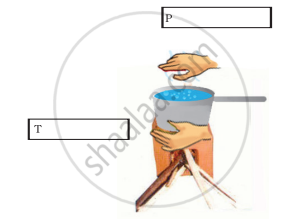Advertisements
Advertisements
प्रश्न
Draw a labelled diagram of a thermo flask. Explain how the transfer of heat by conduction, convection and radiation is reduced to a minimum in it.
उत्तर
Heat transfer is minimised because of:
(1) The vacuum between the two walls, rubber, glass, cork and air do not allow the loss of heat by conduction.
(2) Cork in the neck of flask and the cup over it prevent loss of heat by convection.
(3) Heat cannot be lost by conduction or convection because of vacuum between the two walls.
(4) Heat loss is also minimised by radiation, by making outer surface of inner wall and inner surface of outer wall silvered. The inner wall is a BAD RADIATOR and the outer wall is a GOOD REFLECTOR of radiation.

APPEARS IN
संबंधित प्रश्न
While deciding the unit for heat, which temperature interval is chosen? Why?
What will absorb heat?
Glass
When an object is heated, the molecules that make up the object
Which of the following substances will absorb more heat energy?
The amount of heat gained by a substance is equal to the product of its mass and latent heat.
A marble tile would feel cold as compared to a wooden tile on a winter morning because the marble tile
Observe the picture given in Figure 4.8. Water is being boiled in a pan of wide base.

- Which position P or T will feel warmer?
- Fill up the boxes P and T to indicate the mode of flow of heat to the hand.
Which of the following is true?
The sum of the kinetic and potential energy is called the ______ of the molecules.
Match the following:
| Column A | Column B | ||
| 1. | Heat | a. | Heat gained or lost in the change of state without any change in temperature |
| 2. | m × L. | b. | Heat gained or lost when there is no change of state |
| 3. | Temperature | c. | Form of energy |
| 4. | m × s × t | d. | SI unit of specific latent heat |
| 5. | J/Kg | e. | degree of hotness or coldness |
